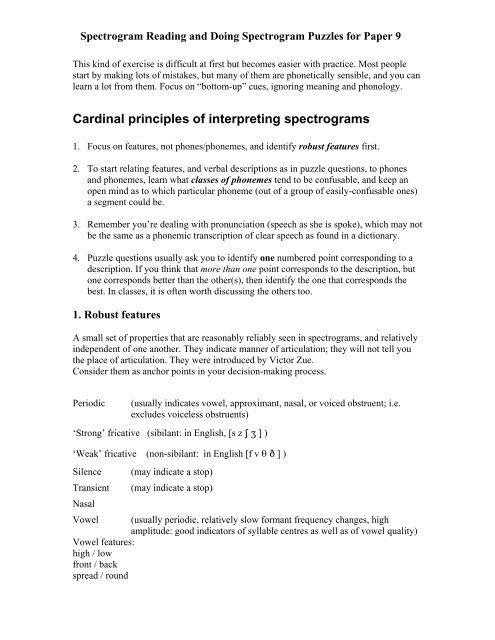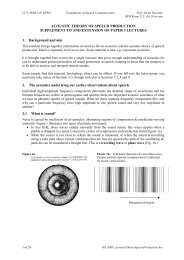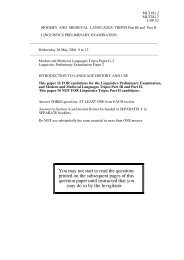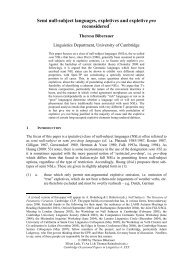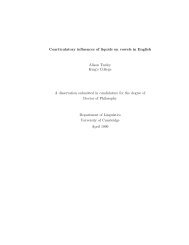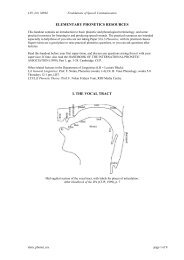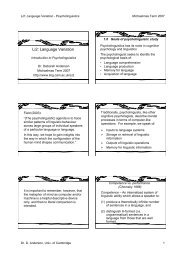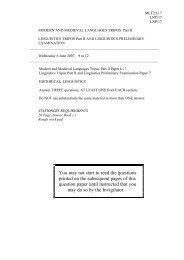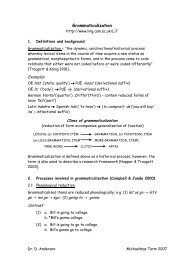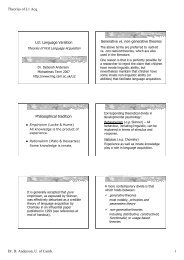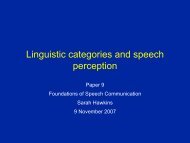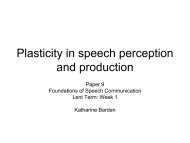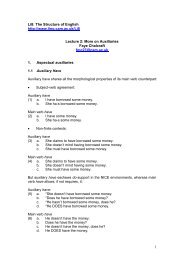“Spectrogram puzzle” classes
“Spectrogram puzzle” classes
“Spectrogram puzzle” classes
You also want an ePaper? Increase the reach of your titles
YUMPU automatically turns print PDFs into web optimized ePapers that Google loves.
Spectrogram Reading and Doing Spectrogram Puzzles for Paper 9<br />
This kind of exercise is difficult at first but becomes easier with practice. Most people<br />
start by making lots of mistakes, but many of them are phonetically sensible, and you can<br />
learn a lot from them. Focus on “bottom-up” cues, ignoring meaning and phonology.<br />
Cardinal principles of interpreting spectrograms<br />
1. Focus on features, not phones/phonemes, and identify robust features first.<br />
2. To start relating features, and verbal descriptions as in puzzle questions, to phones<br />
and phonemes, learn what <strong>classes</strong> of phonemes tend to be confusable, and keep an<br />
open mind as to which particular phoneme (out of a group of easily-confusable ones)<br />
a segment could be.<br />
3. Remember you’re dealing with pronunciation (speech as she is spoke), which may not<br />
be the same as a phonemic transcription of clear speech as found in a dictionary.<br />
4. Puzzle questions usually ask you to identify one numbered point corresponding to a<br />
description. If you think that more than one point corresponds to the description, but<br />
one corresponds better than the other(s), then identify the one that corresponds the<br />
best. In <strong>classes</strong>, it is often worth discussing the others too.<br />
1. Robust features<br />
A small set of properties that are reasonably reliably seen in spectrograms, and relatively<br />
independent of one another. They indicate manner of articulation; they will not tell you<br />
the place of articulation. They were introduced by Victor Zue.<br />
Consider them as anchor points in your decision-making process.<br />
Periodic (usually indicates vowel, approximant, nasal, or voiced obstruent; i.e.<br />
excludes voiceless obstruents)<br />
‘Strong’ fricative (sibilant: in English, [s z ʃ ʒ ] )<br />
‘Weak’ fricative (non-sibilant: in English [f v θ ð ] )<br />
Silence (may indicate a stop)<br />
Transient (may indicate a stop)<br />
Nasal<br />
Vowel (usually periodic, relatively slow formant frequency changes, high<br />
amplitude: good indicators of syllable centres as well as of vowel quality)<br />
Vowel features:<br />
high / low<br />
front / back<br />
spread / round
2. Classes that go together: relating features to phones/phonemes<br />
1. Vowels: if it’s high front, then always consider /i e/<br />
2. Vowels: if it’s low back, then / / (i.e. include the central vowels too?). Figure<br />
out rounding.<br />
3. Vowels: if it’s high back – you guessed it! (though don’t forget that English /u/ is in<br />
many accents phonetically front, so with high F2.) Similarly, if it’s low front or<br />
central.<br />
4. Obstruent voicing: Strong and weak fricatives are rarely confused, but voicing within<br />
these groups can be tough. Likewise voiced and voiceless stops. To tell voicing of<br />
obstruents, look for abruptness of amplitude decay at segment boundaries.<br />
5. All approximants (sometimes confusable with nasals).<br />
6. All nasals (sometimes confusable with approximants).<br />
3. Other tips<br />
1. Remember to consider relative duration and amplitude in making your decisions.<br />
2. Place of articulation is probably hardest. Use formant transitions, and general spectral<br />
shape.<br />
3. Remember that sounds vary according to their context, and that contextual variants<br />
differ between accents, and even, sometimes, speakers.<br />
4. Resources<br />
1. All textbooks discuss spectrogram reading to some extent. I think Ladefoged's chapter<br />
on acoustic phonetics is particularly helpful in a short space. The fourth edition<br />
includes the method we will use, associated with Figure 8.18. (p.188). Later editions<br />
presumably have the same or similar.<br />
2. If you want to go further than we have done in the <strong>classes</strong>, there is an excellent<br />
spectrogram reading course by Victor Zue in folders in the Phonetics Lab. It consists<br />
of 1) notes on each class of sounds and their contextual variants; 2) spectrograms with<br />
the words identified, for illustration; 3) ‘mystery spectrograms’<br />
3. This material is much more advanced than you need for Li9.<br />
4. It is also for American English; expect many differences (e.g. in vowel systems).<br />
5. Waveform reading is less often done than spectrogram reading, but a great deal of<br />
information can be gleaned from waveforms, including some aspects of vowel<br />
quality, the voicing contrast in stops/fricatives. Some papers that discuss it:<br />
Ladefoged, P. (1991) Reading waveforms. Journal of the International Phonetic<br />
Association 21(1), 33-35.<br />
Maddieson, I. (1991) Commentary on ‘Reading waveforms’. JIPA 21(2), 89-91.<br />
Pickett (1999:62-68).<br />
Sarah Hawkins 30 September 2008 sgm-puzzle-notes-08.doc


